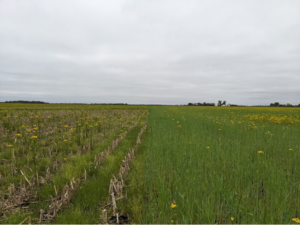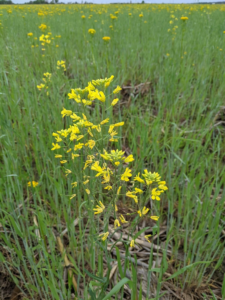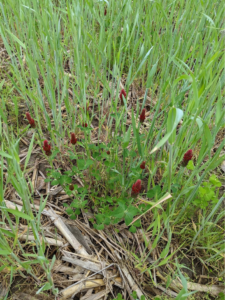Below is a crop update from University of Illinois Extension professionals from across the state for the week of May 12, 2022.
Emerson Nafziger, agronomy specialist and professor emeritus Dept. of Crop Sciences
While we welcome the warm weather that has dried fields and enabled a lot of planting this week, high temperatures and sunshine mean high rates of potential evapotranspiration (PET). We say “potential” because this is the maximum amount of water that would evaporate from an open pan of water. When there’s no crop, water has to move through the soil to the surface, and this slows the rate of water loss some. Still, PET numbers this week are as high as a quarter inch per day, so soils are drying much faster than normal for mid-May. Tillage and planting disturb the soil surface which slows the movement of water to the surface, but if soil does not feel moist to the touch, it might help emergence some to plant seed a little (a quarter of an inch) deeper in order to increase the amount of water available to move to the seed. Soybean seed needs to take in more water to germinate than corn seed, so deeper planting may help soybeans more than corn. Both crops are getting enough growing degree days this week to emerge in about five days; if they do not, check seeds to see why.
Nick Seiter, field crop insect specialist and associate research professor Dept. of Crop Sciences
Insect issues so far have been minimal. I’ve received a report of higher-than-normal alfalfa weevil numbers near Effingham County. Surrounding states have reported higher than average flights of black cutworm moths. If temperatures stay warm and the majority of our acres are planted with favorable conditions for vigorous early season growth, that would go a long way toward mitigating early season insect and slug issues.
Talon Becker, commercial agriculture Extension educator, Central IL
In South-Central Illinois, a few windy days early in the week followed by unseasonably warm temperatures have helped to dry out soils enough to allow for increased field work. Many fields may still are on the wet side for planting, but I’ve seen a lot of spraying activity in the area this past week, both herbicide burndown and fungicide application to flowering wheat. Producers that perform spring tillage have also been busy making those initial tillage passes. Many cover crops are also starting to flower, meaning they have reached peak biomass production. Although still not a common site in most fields, cereal rye-dominant cover crops can be seen in several fields in the area.

Field in Clinton County, half of field receiving cover crop treatment. (Right) Cover crop mix of primarily cereal rye and smaller amounts of crimson clover and rapeseed. (Left) Winter annual weeds with grassed waterway running horizontally in the distance.

Close-up of flowering rapeseed in cereal rye at boot stage. Darker yellow flowers in background are the winter annual cressleaf groundsel (aka butterweed).

Close-up of flowering crimson clover growing amongst cereal rye.
Phillip Alberti, commercial agriculture Extension educator, Northern IL
Drought issues persisting from 2021 have been mitigated partially by but remains to be seen what the long-term implications are. After over 15 days with measurable rainfall totals in NW Illinois throughout April, warm/dry conditions could not come fast enough. And now, it is “go time” in Northern Illinois.
With a drastic positive swing in temperatures over the last week, with minimal precipitation, fields have dried out considerably. Despite being all but silent over the last few weeks, field work (field prep, herbicide/fertilizer applications, and planting) have advanced considerably in a short period of time. We will have better clarity on the amount of corn/soybeans planted by this time next week if conditions hold as expected into next week.
In coordination with the University of Illinois Extension, several community college agriculture programs will be conducting research plots in addition to their own planned field trials. At Highland Community College, Corn and Soybean Variety Trials and a Corn Rootworm Demo plot have been planted. At Illinois Valley Community College (Oglesby) corn and soybean population trials will be planted next week in addition to a Corn Rootworm Demonstration
Dennis Bowman, digital agriculture Extension specialist
After a week of on and off rains, cool temps and little sunshine, things changed in a major way. Field work resumed with a vengeance as soils dried. Dust is now flying while some stubborn ponds still have standing water.
Chelsea Harbach, commercial agriculture Extension educator, Western IL
Things finally got moving this past week in western Illinois after a long-overdue arrival of spring… or should I say summer!? The temperatures this past week were off-the-charts in the low to mid 90s. Plus, the ole midwestern trope of *the humidity*! The temperatures helped dry out fields quickly, and it did not take long for tractors and trucks to get going this week. With 100% transparency, I hit the road to East Lansing on Wednesday this week for a plant-parasitic nematode workshop, so I haven’t been around to witness or scout the goings on the latter half of the week. But one thing I want to mention is the need to scout anything that was planted earlier this spring. With seeds in the ground during the wet/cold periods we had earlier this spring, there is a high chance for uneven stand emergence/adverse effects of soilborne pathogens. Assessments must be made to determine if any areas in the fields will need replanted.
As of 5/12/2022 in Knoxville, IL, our year-to-date growing degree day accumulation was 212, with more than half of those GDD coming from our first 12 days in May. Needless to say, I think our subsequent crop updates will have a lot more interesting content as, without doubt, crops seeded this week will be popping up before we know it.




 and then
and then